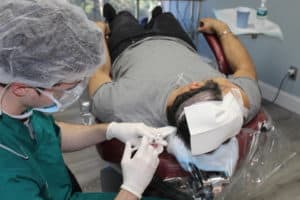Is a Hair Transplant Painful?
It goes without saying that patients want to avoid pain during any medical or surgical procedure. Especially if the procedure is an elective or cosmetic one. So, it stands to reason that patients frequently ask about pain and hair transplant surgery. Specifically, they want to know if a hair transplant is a painful procedure or if they will feel any pain during surgery?
Is a Hair Transplant Painful?
Thankfully, the answer is: no, a hair transplant is not a painful procedure. However, this does not mean there is absolutely no discomfort whatsoever. Even the most minimally invasive or benign medical procedures do have some degree of discomfort, and a hair transplant is no exception. Luckily the “pain” is brief and temporary. Most patients report almost no pain whatsoever and describe a hair transplant as a very easy and somewhat pleasant experience. Although it may be an “easy” experience, patients should still understand what this entails and what sort of discomfort they may feel before, during, and after surgery.
Before Surgery

Dr. Bloxham numbing the donor area.
The only real discomfort a patient feels during a hair transplant involves the numbing medication. Once the scalp is prepped and numb, a patient feels nothing throughout the entire day. The process of numbing the scalp is done in two parts: numbing in the donor area where we take the grafts from; and numbing in the recipient area where we will implant the new grafts. Numbing in the donor area happens before the surgery itself really begins. The first thing the doctor will do the morning of surgery after the plan is clearly marked and the scalp is cleaned and trimmed is numb the donor area. Using a local anesthetic — the same type of medication the dentist uses to numb before filling a cavity — the doctor will inject small amounts of the medication across the entire region. The injections are superficial, quick, and done using a very fine needle. Because of this, pain is minimal. Most patients equate it to a slight “pinching” sensation quickly followed by numbness as the medication “kicks in.” While it takes around 10-15 minutes for the numbing medication to take full effect, most patients report feeling numb within seconds to minutes. After this, nothing else is felt in the donor region. The doctor can extract the tissue — either via the FUT/strip or FUE technique — without the patient feeling anything. The numbing medication typically lasts for 3 hours and is periodically touched-up throughout the day before it wears off and patients may experience discomfort.
During Surgery
As described above, patients will feel nothing during the extraction aspect of surgery after the numbing medication is applied. However, a hair transplant, simplified, is completed in two parts:

Dr. Bloxham injecting numbing medication into the recipient area.
removal of the grafts from the donor and re-implantation of the grafts in the recipient areas (the balding and thinning regions). Just like in the donor region, the recipient region must be numbed before the doctor can make incisions and the grafts can be placed back into the scalp. This process is identical to the donor numbing; the doctor will inject the same local anesthesia into the recipient region (or, more accurately, directly in front of the recipient region several millimeters in front of the hairline) and the entire area will numb within a few minutes. After the numbing sets in, the doctor and technicians can work in the area without the patient feeling anything. The numbing in the recipient region is the last thing the patient will feel the entire day. After this, the entire scalp — from the very front to the donor in the very back — is completely numb. The entire surgery can now be completed without any discomfort. While the patient may want to readjust and take breaks to stretch and walk around to avoid the discomfort of sitting for a long period, there will be no physical pain from the surgery itself. If the patient does start to sense pain, he or she will let the staff know and the doctor will inject more numbing medication.
After Surgery
So we know patients will have no pain during surgery after the anesthesia is administered, but what about after surgery? What happens after the numbing medication wears off? Thankfully, patients report very little to no discomfort after surgery as well. The doctor will re-administer the numbing medication after surgery is finished. This means the patient has approximately 3 hours of numbness before it wears off and any sort of potential discomfort may occur. The patient now has 3 hours to get back to where they are staying, get settled, and, most importantly, begin the post-operative pain medications. If the patient takes the oral medication as instructed and builds up some pain medication in their system before the numbing wears off, they should transition nicely and feel no discomfort. They will then take the pain medications several more times as instructed the night of surgery, and go to bed pain free. By the next morning, all potential for pain should be gone. The vast majority of patients report feeling no pain and do not need any sort of medication the day after surgery. If they do experience any slight discomfort, they should have a few remaining pain pills to utilize or they can take Tylenol (acetaminophen). However, this is only for minimal discomfort and most patients do not even need this.
So, is a hair transplant painful? Thanks to local anesthesia and post-operative pain medications, no, a hair transplant is not painful. While no surgery can be completely painless and some brief and likely temporary level of discomfort is possible, a hair transplant is typically a pleasant and easy experience for most hair loss sufferers.
________
Feller & Bloxham Medical, PC





